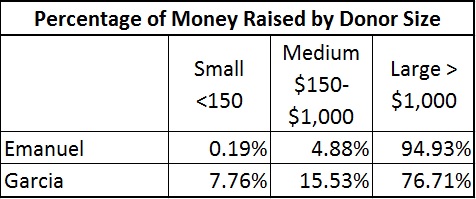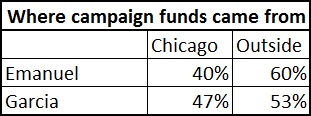By The Illinois Public Interest Research Group
Thicker wallets gave big donors an outsized voice in this year’s mayoral election, according to new analysis of campaign finance data by Illinois PIRG Education Fund.
Contributions greater than $1,000 accounted for 92% of the money contributed to the Emanuel and Garcia campaigns, while under 2% of the money contributed came from contributions of less than $150. A clear majority – 58% – of money contributed, came from donors living outside Chicago.
“Our democracy is built on the principle of one person, one vote,” said Illinois PIRG education fund director Abe Scarr. “But the race for big money gives big donors an outsized voice in our elections.”
The Emanuel campaign raised 95% of its funds from donors giving over $1,000 and 0.2% of its funds from donors less than $150. The Garcia campaign raised 77% of its funds from donors giving over $1,000 and 8% of its funds from donors less than $150.

*
In the last six months of the campaign the Emanuel campaign raised $14,194.94 from small donors while the Garcia campaign raised $386,212.93 from small donors. Because contributions under $150 are non-itemized, we do not know how many small donors this represents. If each small donor gave $150, it would represent 95 and 2,575 donors for the Emanuel and Garcia campaigns respectively.

*
Voters in Chicago had the opportunity to weigh in on possible solutions to the problem of big money in elections by voting on an advisory ballot question on small donor campaign finance solutions – 79% of voters supported the measure. Emanuel and Garcia both endorsed the question.
“Local, state, and federal elected officials should heed the call of Chicago voters by advancing reforms that diminish the dominance of big money in our elections and empower small donors to have a greater impact,” said Scarr.
There are successful, proven models to empower small donors so that their voices play a more central role in our democracy, such as providing tax credits and public matching funds for small contributions.
For example, in New York City’s 2013 city council campaigns, small donors were responsible for 61% of participating candidates’ contributions when funds from a matching program are included. All but two of the winning candidates participated in the program, showing that candidates are able to raise the money they need to win without looking for large-dollar contributions.
Predicting the exact impact of a small donor program is impossible because participating candidates would change their fundraising strategies. However, it is still illuminating to examine what the impact of a small donor match could be. If, for the last six months of the campaign, small contributions were matched 6 to 1, as they are for candidates participating in New York City’s small donor program, the Garcia campaign would have received 37% of its funds from small donors, while the Emanuel campaign would have received 0.6% of its funds from small donors, with the match factored in.

*
Finally, more of the Emanuel campaign’s funds came from outside of Chicago, but both campaigns received a majority of campaign funds from donors living outside of Chicago.

*
Notes on methodology:
The analysis examined contributions to the two candidates between February 24th, 2011 and March 31st, 2015, the end of the last quarterly report. For the purpose of the analysis we considered individual contributions, transfers in, and non-itemized contributions. The analysis does not include non-itemized contributions in the first quarter of 2011 because most if not all of them would have been for the previous mayoral election.
–
Comments welcome.
Posted on May 1, 2015


